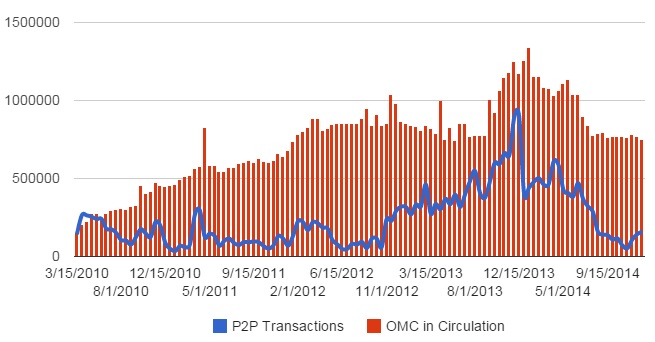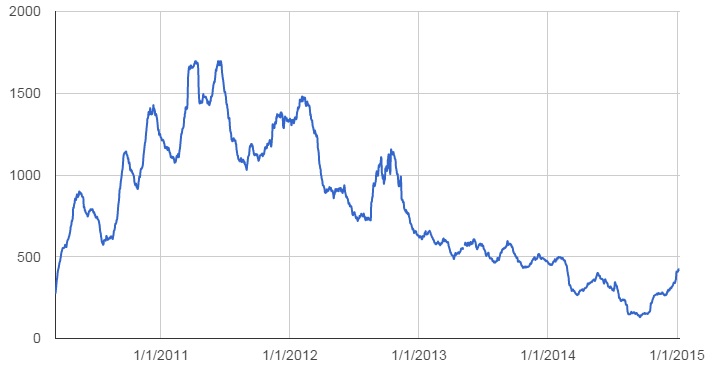If 2014 was the year of the hypergrid — and it was — then it should also have been the year of the OMC.
After all, the OMC, or Open Metaverse Currency, is the only currency which works on the hypergrid and is backed by a trusted exchange, Austria’s Virwox. If your avatar has an OMC account, then any time you travel to an OMC-enabled region, your OMC balance will show up in the viewer and you will be able to buy stuff with your OMC.
According to Virwox, the OMCÂ is accepted by 67Â different grids.
On paper, the OMC looks great. And I, personally, had very high hopes for it when it first launched — and at the start of every year after that.
The whole picture
But if you take a closer look at the OMC, the picture changes dramatically.
First of all, the list of 53 grids that accept the OMC that are listed on the Virwox website is not accurate, and neither is the list of 67 grids available through its JSON API.
Once you subtract out the duplicate listings, the grids that are closed or have merged with other grids, or that never did open to the public in the first place, you’re left with just 21 grids — out of a total of more than 250 active public OpenSim grids.
Still, 21 grids is a lot better than any other currency, most of which are limited to just a single grid.
But of those 21 actice grids, not all actually accept OMC. Some experimented with the currency at some point in the past, then dropped it.
DreamNation, for example, launched its own currency last July after learning that Virwox was actually withdrawing money from unused accounts. Other active grids listed as accepting the OMC include Avination, Zandramas, and Island Oasis, which also all use their own, local currencies. OSgrid is also listed, though it’s been down since August.
Virwox does offer a few other ways to gauge the health of the currency, however, including active avatars, user-to-user transactions, and total OMC in circulation.

The amount of OMC in circulation dropped from an all-time peak of $5,262 last January to a new low of $2,837 a week ago. Meanwhile, as big-name grids continued to switch away from the OMC, the value of transactions declined dramatically over the course of the past year, as well.
Another way to look at the use of the OMC currrency is in terms of the active avatars using it.

Usage hit a lot of just 131 avatars in mid-September, and has grown since then to 420 avatars — but still a dramatic fall from its peak of around 1,700 active avatars in mid-2011.
Signs of a turnaround
A couple of new grids have jumped on the OMC bandwagon over the past few months, including Xmir and Your2Live.
“Virwox is the only company with OpenSim payments,” Your2Live grid founder Harrit van Beek told Hypergrid Business. “That, for us, was the main reason why we chose it.”
However, it wasn’t simple to set up, van Beek said, since the grid uses Windows instead of Linux.
“What we have done is compile OMC on a Linux Debian VPS running Virtubox, then take the DLL file and copy it over to Windows,” he said. “This is the most simple way. The only other solution is to compile on Windows yourself.”
The rest was straightforward, van Beek said, a matter of following the official OMEconomy module instructions. He also added that he exchanged about half a dozen emails with Virwox about how the currency works.
Xmir switched to the OMC last month,

“The stores are now equipped with vendors that let you purchase in OMC, or get the item from the Kitely Market,” Xmir founder Geir Nøklebye told Hypergrid Business.
However, The Great Canadian Grid, which was initially considering OMC, decided to go with their own currency, grid founder Roddie Macchi told Hypergrid Business because the OMC currency requires that users go to Virwox website to set up their currency, and go through an extra confirmation step each time they buy something.
“Its just too much to do for the customer,” he said. “People want things to be quick like in Second Life. And the best way is to just do it yourself for them and provide them a fast currency module within our own servers.”
Another problem often cited by grids and hosting vendors trying to deploy the OMC currency is the lack of support from Virwox itself. Virwox trades the currency, and provides the API — the application programming interface that allows other software to use the exchange. But it does not actually offer the software that grids have to install in order to enable OMC on their grids.
That software, known as the Open Metaverse Economy Module, is an open source project developed and maintained by the Graz University of Technology in Austria.
In the past, it was sometimes difficult to get help with the module since it was a free, open source project that didn’t belong to any company in particular.

Lukas Eberhard says he will change that.
“I’m working at Graz University of Technology in Austria and I’m now supporting the OMC,” he told Hypergrid Business. “Currently, there is only one issue with the Great Canadian Grid since they upgraded their servers. But we are still working on a solution to solve the problem.”
Other grids have been able to roll out the OMC smoothly, he added.
“As you can see, the Xmir grid started new with OMC and the installation and also the support was fine,” he said. “I hope the reports you heard did not put a wrong complexion on OMC and its support.”
- OSgrid back online after extended maintenance - April 16, 2025
- Analysts predict drop in headset sales this year - March 25, 2025
- OSgrid enters immediate long-term maintenance - March 5, 2025
